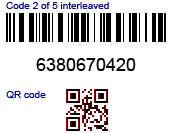

#BARCODE NUMBER CODE#
Click here to learn more.Ĭommonly found in warehouse, distribution, and manufacturing, Code I 2 of 5 is a numeric-only barcode used to encode pairs of numbers. Code 128 features an automatic switching setting that allows users to optimize it for barcode length. Click here to learn more.ĭerived from the ASCII 128 character set (0-9, a-z, A-Z, and some special characters), this compact barcode is used extensively in packaging and shipping applications worldwide. If space is a concern, Code 128 would be a better choice to consider. It is a lineal, 1D, alphanumeric code with the ability to include the entire 128 ASCII character set and extend to any length, only limited by the size of the label. This is one of the oldest barcodes around and is a common symbology found in electronics, healthcare, and government. Why not learn more about how barcodes can better serve you? For instance, the recent surge of 2D barcoding has proven popular by allowing you to scan straight from your smartphone for a wealth of data. Barcode technology never stops advancing. Speaking Another Language: Barcode Symbologies differ in qualities such as capacity and linearity, making some advantageous for particular uses and industries.

Each symbology follows an algorithm for standardizing the encoding and storing of these characters. Rather than manually writing and copying this information, it becomes encrypted in barcode languages (symbologies) for fast transfer through a scanner to computer. These strings of characters can designate all types of information. They are basically a license plate that is linked to data files. Here’s an easy way to understand how barcodes work: think of them as a more technologically savvy way to transfer strings of characters. Barcode Types Explaining the Different Barcode types


 0 kommentar(er)
0 kommentar(er)
